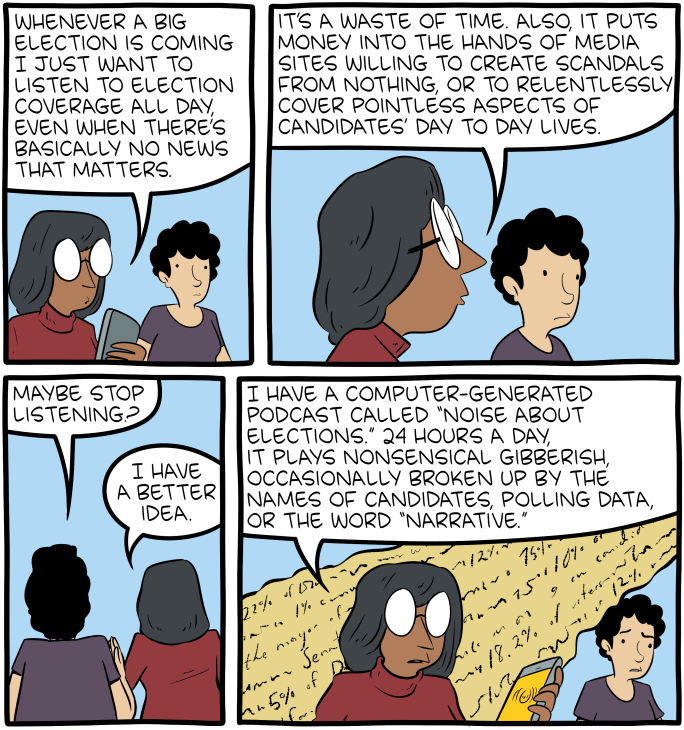Was it "people of colour" or "people of talent"?
Jim Waterson, "Channel 4 apologises over subtitle error on viral Boris Johnson clip (Tory anger after tweet claims PM said ‘people of colour’ instead of ‘people of talent’)", The Guardian 12/6/2019:
Channel 4 News has apologised after a subtitling error wrongly claimed Boris Johnson had discussed whether “people of colour” should be allowed into the UK, prompting the Conservatives to accuse staff at the channel of being campaigners rather than journalists.
In a clip of the prime minister uploaded to Channel 4’s social media accounts, Johnson was captioned as saying: “I’m in favour of having people of colour come to this country but I think we should have it democratically controlled and have it done that way.”
In reality, Johnson said he was in favour of having “people of talent” come to the UK, and did not discuss race.
The falsely subtitled clip went viral on Friday, prompting Channel 4 to issue a correction: “Boris Johnson says ‘people of talent’ not ‘people of colour’. Our earlier tweet was a mistake. We misheard and we apologise.”
Some people who had shared the clip continued to wrongly insist the prime minister had said the word “colour”. This suggested it may be an example of people’s hearing being influenced by visual cues – similar to the known phenomenon of the McGurk effect. It also echoes the confusion at the end of last year over whether a voice in a short audio clip was saying the word “laurel” or “yanny”.
Read the rest of this entry »
HouseHold GarBage
Dick Margulis saw this in a hospital waiting room in the University of Hong Kong Shenzhen Hospital:
Read the rest of this entry »
Attachment ambiguity of the week
Annie Ropeik, "N.H. Defends Laconia Law Barring Female Nudity In U.S. Supreme Court Appeal", New Hampshire Public Radio 12/6/2019:
New Hampshire has filed a response with the U.S. Supreme Court in the so-called “Free the Nipple” case of three women arrested for going topless at Weirs Beach in 2016.
The high court had asked to hear from the state, which an attorney for the women appealing says shows at least one justice may be interested in the issue.
The women say the Laconia ordinance under which they were convicted is unconstitutional and discriminates based on gender.
Read the rest of this entry »
The right boot of the warner of the baron
Here at the UNESCO LT4All conference, I've noticed that many participants assert or imply that the problems of human language technology have been solved for a few major languages, especially English, so that the problem on the table is how to extend that success to thousands of other languages and varieties.
This is not totally wrong — HLT is a practical reality in many applications, and is being rapidly spread to others. And the problem of digitally underserved speech communities is real and acute.
But it's important to understand that the problems are not all solved, even for English, and that the remaining issues also represent barriers for extensions of the technology to other communities, in that the existing approximate solutions are far too hungry for data and far too short on practical understanding and common sense.
Read the rest of this entry »
"An indefinite, renewable interprofessional strike"
I'm in Paris for the UNESCO International Conference Language Technologies for All (LT4All), which happens to coincide with another event in France, a national strike that (among other things) created a very long trip from the airport. In my hotel's elevator there was a sign whose first sentence taught me a couple of new words:
Ce Jeudi 5 Décembre aura lieu une grève interprofessionelle reconductible indéterminée.
There was also an English translation:
This Thursday, December 5th, will be an indefinite, renewable interprofessional strike.
"Collapsed" calligraphy
Responding to this recent post about machine analysis of grammar, "Literary Sinitic / Classical Chinese dependency parsing" (11/27/19), Nicholas Morrow Williams writes:
That reminds me tangentially of something I just heard about, an effort to transcribe Japanese "kuzushiji" (cursive-like) script using AI. This article, which contains some striking illustrations, is about a huge international competition to devise a better method, won apparently by a Chinese team.
Read the rest of this entry »
Agu hair bian
Here I am standing in front of a hair salon near the south gate of Kansai University in Osaka, Japan two days ago:
Read the rest of this entry »
Tibet water
Ben Zimmer was just passing through Hong Kong Airport, where he got a bottle of Tibet 5100 spring water, complete with Tibetan script:
Read the rest of this entry »
Apostropocalypse again
"'Laziness has won': apostrophe society admits its defeat", The Guardian 12/1/2019:
John Richards, who worked in journalism for much of his career, started the Apostrophe Protection Society in 2001 after he retired.
Now 96, Richards is calling time on the society, which lists the three simple rules for correct use of the punctuation mark.
Writing on the society’s website, he said: “Fewer organisations and individuals are now caring about the correct use of the apostrophe in the English language.
“We, and our many supporters worldwide, have done our best but the ignorance and laziness present in modern times have won!”
Read the rest of this entry »
Tero: an English word in Japanese garb
Three days ago, I passed through immigration at Kansai International Airport (near Osaka). I was struck by a large, prominently displayed word in katakana (syllabary for transcription of foreign words and onomatopoeia): tero テロ.
Since I was in a restricted area of the airport, naturally I couldn't take a picture of the signs with this word on them, but I knew right away from the circumstances what it signified: "terrorism" — they were taking strict precautions against it.
Read the rest of this entry »
Multiscriptal face writing
We've mentioned "kaomoji " before (see "Readings"), but only gave a few examples.
"Kaomoji 顔文字 ("face character / writing") is a Japanese term for more or less elaborate "drawings" composed of kana, characters, punctuation marks, and now letters and other symbols drawn from a wide range of writing systems. They can be quite fanciful, even florid. Some of them are exquisite, breathtakingly beautiful.
I hadn't seen many of them in the past, but in the last few days, Diana Shuheng Zhang started sending a bunch of them to me, and I found them utterly captivating, so I've decided to share some delightful kaomoji with Language Log readers.
Read the rest of this entry »
"Knock it off, algorithms!"
An experience that's become all too common — as documented in Zits for 11/25 through 11/28:
Read the rest of this entry »





